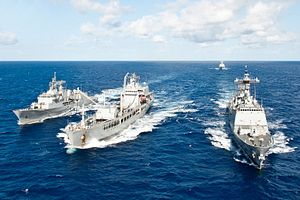Last week, New Zealand’s government released a new Defense White Paper for 2016 to coincide with the release of an ambitious defense spending plan that earmarks $14 billion for the development of various capabilities over the next 15 years. New Zealand last published a white paper on defense in 2010 and has since then released multiple Defense Capability Plan documents that outline strategic priorities and procurement plans. (The Diplomat discussed the most recent New Zealand Defense Capability Plan in 2014.) The government of New Zealand is expected to release a Defense Capability Plan later this year, outlining its procurement plans and concerns in more detail.
New Zealand is planning this ambitious expansion of the scope and capabilities of the New Zealand Defense Force while keeping spending on defense at “arguably no less than one percent of GDP in terms of spending and probably a bit more over time,” according to Prime Minister John Key. The $14 billion spending plan will include planned replacements for New Zealand’s Boeing 757s, C-130 Hercules transport aircraft, and P-3 Orion surveillance aircraft. (The latter will see its existing intelligence, surveillance, and reconnaissance capabilities improved before a full replacement in the 2020s.)
The new white paper mentions simmering regional disputes, including the South and East China Seas. It notes that New Zealand is “reliant on seaborne trade and the security and freedom of air and sea navigation for economic prosperity and wellbeing,” and that “over half of New Zealand’s maritime trade passes through the South China Sea.” The white paper describes the South China Sea as a “contested environment” and voices support for “international efforts to promote freedom of navigation” there and elsewhere.
At the same time, the document outlines China’s status as an “important strategic partner” for New Zealand, underlining that defense and security cooperation between the two countries has “gained momentum in recent years.” Above all, the document reiterates neighboring Australia’s continued status as New Zealand’s “most important bilateral partner,” stating that it is “critical that the Defence Force maintains its ability to operate effectively with its Australian counterpart.” Regarding the United States, the white paper throws New Zealand’s support behind the United States’ “rebalance” to Asia, noting that the relationship with Washington will “remain one of this country’s closest.”
The white paper includes some additionally interesting perspectives on other Asian states’ roles in regional security. For instance, Japanese Prime Minister Shinzo Abe will be happy to read that New Zealand “welcomes Japan’s recent moves to make a more proactive contribution to international security.” Moreover, the white paper identifies ASEAN forums, including the ASEAN Defense Ministers’ Meeting Plus (ADMM-Plus), as valuable regional initiatives. Curiously, despite reciprocal state visits by Prime Minister Key and former Vietnamese Prime Minister Nguyen Tan Dung last year, the white paper makes no specific mention of Vietnam. (Key and Nguyen have supported expanding bilateral defense ties.)
While the white paper does acknowledge the inevitable primacy of Asian strategic affairs on the global stage and looks toward contested spaces in the East and South China Sea, there is a noticeable focus on New Zealand’s southern flank, namely Antarctica and the Southern Ocean. The ministerial foreword to the paper couches this in terms of efforts to support increased awareness within New Zealand’s exclusive economic zone, but critics note that the paper places a curious degree of emphasis on what is essentially a “useful secondary task” for the NZDF.
In presenting the budget in Parliament, Key emphasized New Zealand’s unique capability to serve as a first responder of sorts in the Southern Pacific, pointing to the NZDF’s recent involvement in helping Fiji recover from Cyclone Winston. “You think about what the military do other than just giving us sheer protection, they also have a big humanitarian role in what they do,” Key noted. Accordingly, the White Paper notes that continued “economic, social, environmental and governance pressures” for South Pacific countries mean that the NZDF can expect continued humanitarian assistance/disaster relief (HA/DR) deployments in the coming future.
Read the full New Zealand 2016 Defense White Paper here (PDF).

































